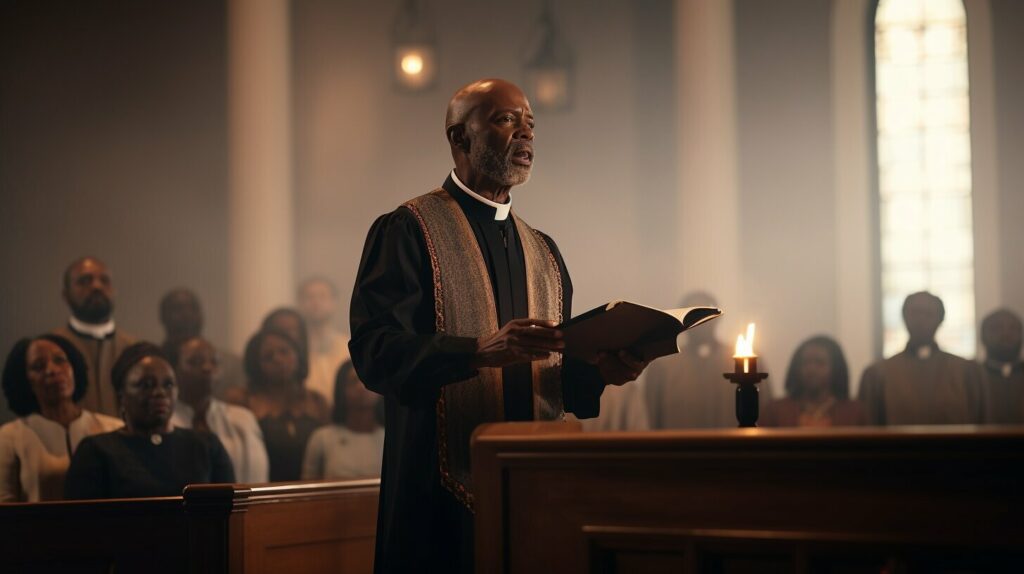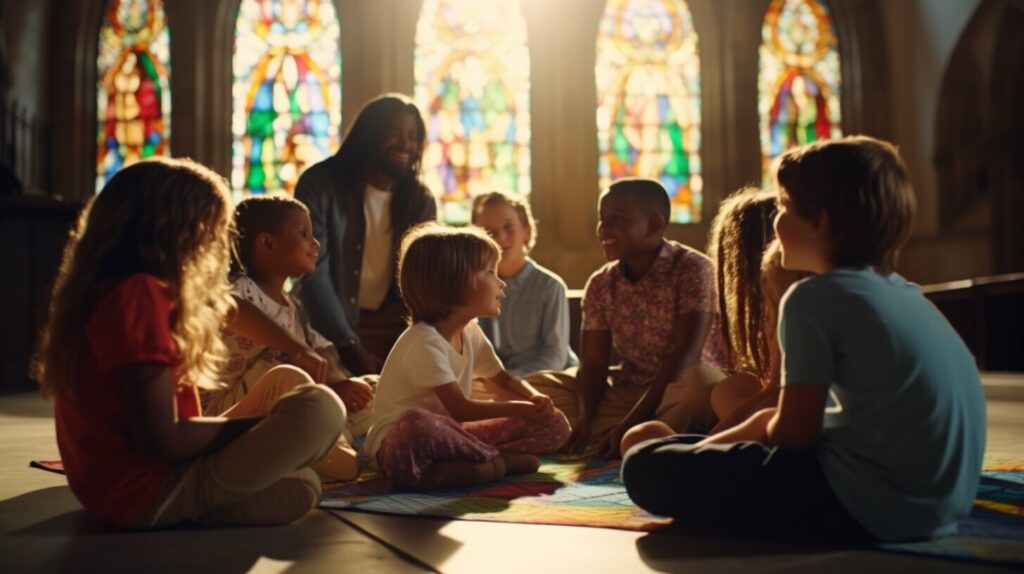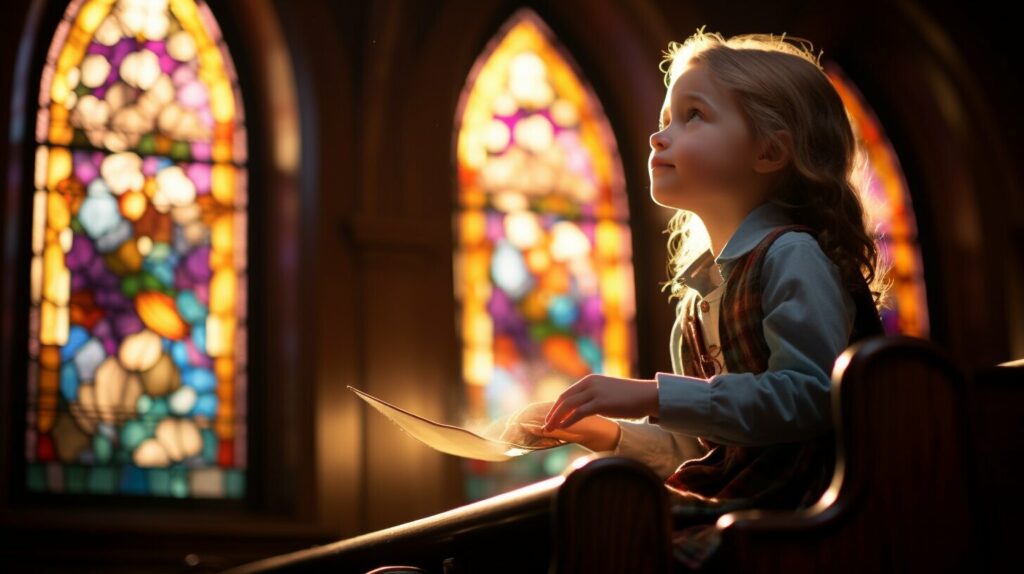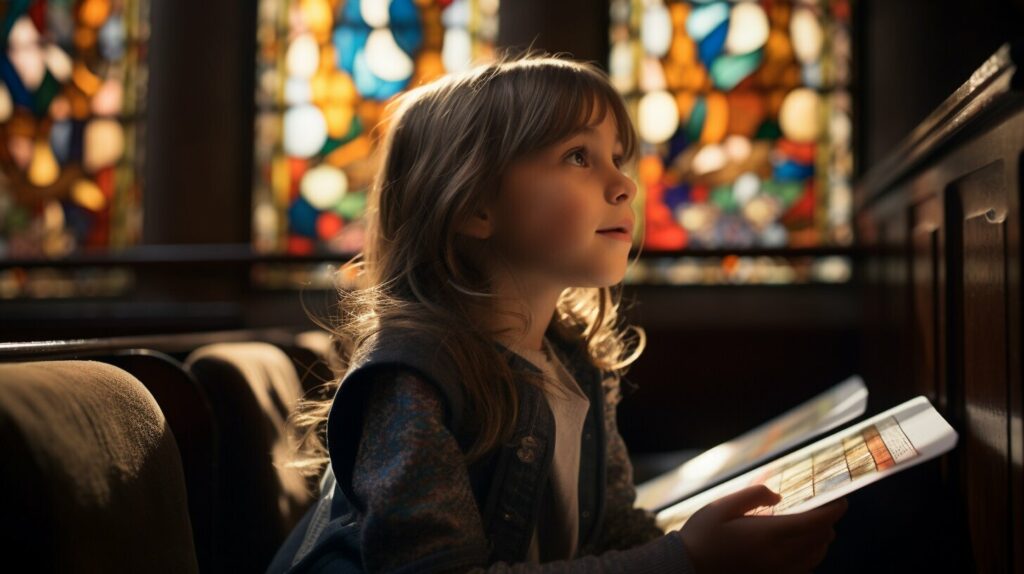If you’re a religious parent, you may have wondered how to explain church to your child in a way that they can understand and engage with. Church can be a complex and intimidating concept, but it doesn’t have to be. With a little bit of guidance, you can help your child to understand the importance and meaning of church.
This guide will provide you with simple and engaging explanations of church and its significance, as well as tips on how to answer your child’s questions and address any curiosities they may have. By the end of this guide, your child will be excited and eager to learn more about church and its community.
Key Takeaways:
- Explaining church to a child can be challenging, but with the right guidance, it can be simple and engaging.
- This guide will provide you with an overview of church and its significance, as well as tips on how to address your child’s curiosities.
- By the end of this guide, your child will have a better understanding of church and its community.
Why It’s Important to Teach Children About Church
If you’re wondering why it’s important to teach children about church, the answer is simple: religious education can help shape their values, beliefs, and attitudes. When children learn about church and religion, they gain a sense of purpose, community, and moral guidance that can positively impact their lives.
By teaching children about church, you are providing them with a way to connect with a higher power, which can offer comfort during difficult times and provide a sense of hope and optimism for the future. Additionally, religious education can instill a sense of empathy, compassion, and respect for others, which is particularly important in today’s diverse and complex society.
Furthermore, learning about church can help children develop critical thinking skills and encourage them to ask questions about the world around them. By exploring the teachings and principles of their faith, children can gain a deeper understanding of themselves and the world, and become more open-minded and tolerant individuals.
All in all, teaching children about church is an essential part of their growth and development, providing them with a strong foundation of values, beliefs, and morals that will guide them throughout their lives.

What Is Church?
Church can be defined as a place of worship where people gather to honor and praise God. It is a special and sacred place where individuals and families come together to connect with their faith and each other.
The word “church” can also refer to the community of people who gather, whether it’s a local congregation or the global Church as a whole. Churches can come in various shapes and sizes, with different architecture and traditions, but they all share the purpose of creating a space for worship and fellowship.

| Parts of a Church | Description |
|---|---|
| Altar | The table in the front of the church where Communion is served and where the priest or minister leads the service. |
| Pews | The benches where people sit during the service. |
| Stained Glass Windows | The colorful windows that depict religious scenes or figures. They add beauty and symbolism to the church. |
Understanding what a church is and its purpose can help children feel more comfortable and engaged when attending services or events. It can also provide a foundation for their growing faith and spiritual journey.
Exploring the Parts of a Church
Understanding the different parts of a church is essential to comprehending its purpose and significance. Let’s explore the various components that compose a church:
| Part of a Church | Purpose |
|---|---|
| Altar | The central place of worship, where the Eucharist is consecrated and received |
| Pews | Where the congregation sits during services and worship |
| Stained Glass Windows | Depicting biblical scenes or saints, they add beauty and inspiration to the church atmosphere |
Other parts of a church include the pulpit, where the priest delivers sermons, the baptismal font, where people are baptized, and the choir loft, where the choir sings during services. Each element plays an important role in the spiritual experience of church-goers.

By understanding the different parts of a church, children can gain a greater appreciation for the purpose and significance of this religious place. The next section will further explore the rituals and traditions that take place in a church.
Church Rituals and Traditions
Attending church services involves participating in a variety of rituals and traditions that are important to the faith. Understanding the meaning and significance of these practices can help your child engage more fully with the church community.
One of the most common rituals is prayer. At certain times during the service, the congregation may recite prayers or engage in silent meditation. Prayers can take many forms, from simple expressions of gratitude to more formal recitations.
Singing hymns is another important tradition in many churches. Hymns are religious songs that praise God and express faith. They can be sung by the entire congregation or by a choir.
Many churches also celebrate sacraments, which are religious ceremonies that mark important milestones in a person’s faith journey. The most common sacraments include baptism, confirmation, and communion. Each sacrament has its own unique rituals and significance.
Other church traditions may include lighting candles, receiving blessings from a priest or minister, and participating in special services for holidays such as Christmas and Easter.
By participating in these rituals and traditions, your child can deepen their connection to the church and gain a greater understanding of their faith.

Role of a Priest or Minister
Have you ever wondered who leads a church and what their role is? That would be the priest or minister! They are in charge of the spiritual welfare of the congregation, and help to guide and instruct worshippers as they grow in their faith.
Priests or ministers are often highly respected individuals in the community and are seen as spiritual leaders. They are ordained by the church and have undergone extensive training to be able to fulfill their duties. Among their responsibilities are leading the worship services, administering the sacraments, such as baptism and communion, and providing counseling and support to those in need.
The priest or minister is an integral part of the church community, and they often act as a bridge between the congregation and God. They are there to guide and support individuals on their spiritual journey, and to help them connect with their faith.
It’s important to note that while the priest or minister has an important role within the church, they are also human and imperfect, just like everyone else. They may make mistakes or have their own struggles, but their faith and dedication to serving the community drives them to continue in their role.

Overall, the priest or minister plays a critical role in the church, and their guidance and leadership help to shape the spiritual lives of the congregation. Whether you’re a child or an adult, it’s important to have an understanding of their role as you learn more about the church and your faith.
Community and Fellowship at Church
Attending church is not just about sitting through a sermon. It’s a chance for children to meet new people and create lasting friendships. Church offers a sense of community and fellowship where everyone is welcome with open arms, regardless of their background.
In fact, some churches have specific programs designed for children to socialize, play games, and learn together. These programs can help children feel comfortable and connected to their church community.
When you attend church with your child, take the time to introduce them to others in the community. Encourage them to participate in group activities and make new friends. This can help your child feel more connected to their church and foster a sense of belonging.
Remember, church is not just a place where children go to learn about religion. It’s also an opportunity for them to find support, friendship, and a sense of belonging.

Answering Questions and Addressing Curiosities
As a child learns about church, they may have questions or curiosities about different aspects of it. It’s important to create a safe space where they feel comfortable asking questions and expressing their thoughts.
When your child asks a question about church, try to answer it in a way they can understand. Use language they are familiar with and try to relate it to their own experiences. For example, when explaining the concept of prayer, you could say something like, “Prayer is like talking to a friend, but instead of using words we talk to God with our hearts.”
Encourage your child to ask questions and express their curiosities. This can help them feel more involved in the learning process and develop a deeper understanding of church. You could also ask questions yourself to prompt deeper thinking and reflection, such as “What do you think we can learn from going to church?” or “How does going to church make you feel?
It’s also important to be honest with your child when you don’t know the answer to a question. You could say something like, “I’m not sure, but let’s find out together.” This can be a great opportunity to learn something new with your child and deepen your own understanding of church.
Remember, every child is unique and may have different questions or curiosities about church. By being patient, understanding, and open-minded, you can create a positive and enriching learning experience for your child.

Attending Church Services and Events
Attending church services and events is an essential part of understanding and experiencing the church community. Regular attendance will help your child feel more connected to the church, understand its traditions, and develop a deeper sense of faith.
Most churches offer Sunday services, which typically lasts for an hour or so, and include prayer, hymns, and a sermon. Some churches also offer weekday services or evening events, such as Bible study groups or youth groups, which can be a great opportunity for your child to interact with other children their age.
It’s important to inform your child of what to expect during the service or event and encourage them to participate in the traditions, such as singing along to hymns or reciting prayers. Remember to dress appropriately for the occasion, too.
Attending church services and events will also give your child opportunities to participate in community service activities, such as volunteering at a food bank or organizing a fundraiser. These experiences can teach them the importance of giving back to the community and putting their faith into action.

By attending church services and events, your child can learn important values and virtues, gain a sense of community, and develop a deeper connection to their faith. Encourage them to participate and engage in the church community, and help them appreciate the joy and fulfillment that comes with being part of something meaningful.
Teaching Values and Lessons through Church
Church is a place where children not only learn about the religious beliefs and practices, but also about important values and life lessons. Through various activities and interactions, children can develop a sense of compassion, empathy, and community spirit that can help them become better individuals.
One of the core values that children can learn through church is kindness. They can be taught to treat others with respect and care, and to help those in need. For instance, children can participate in charity events, volunteer activities, or simply offer emotional support to those who are struggling.
Another important lesson that children can learn through church is love. They can be taught to love themselves, their family, their friends, and their neighbors, and to express their love through words and actions. Through church, children can also learn about the concept of unconditional love, which is the essence of many religious teachings.
Forgiveness is another value that children can learn through church. They can be taught to let go of grudges and resentments, and to seek reconciliation with others. By practicing forgiveness, children can develop a sense of inner peace and emotional maturity, which can benefit them in various aspects of their lives.
In addition to these values, children can learn many other life lessons through church, such as patience, honesty, responsibility, perseverance, and gratitude. By participating in various activities and programs, they can develop their skills and talents, and learn to become responsible and contributing members of society.

“The church can be a place of transformation, where children learn not only about their faith, but also about their place in the world and their responsibility to others.”
Through all of these experiences, children can develop a sense of purpose and meaning, and connect with a community of like-minded individuals who share their beliefs and values. They can also gain a sense of hope and optimism, as they learn to navigate life’s challenges and setbacks with resilience and determination.
If you want your child to learn these important values and lessons, consider getting involved in a local church or religious organization. Encourage your child to participate in various activities and programs, and be a role model for them by practicing these values in your own life. With your guidance and support, your child can develop a deep and meaningful connection to their faith, and find inspiration and guidance for a fulfilling life.
Conclusion
Congratulations! You have successfully learned how to explain church to a child in a simple and engaging way. Remember that teaching children about church is important in helping them understand their faith and beliefs. By providing them with a basic understanding of what a church is, breaking down its different parts and rituals, explaining the role of a priest or minister, and highlighting the importance of community and fellowship, you have given them a solid foundation to develop their spiritual lives.
Don’t forget to answer their questions and address their curiosities about church. Encourage them to attend church services and events so they can fully experience and learn more about their faith. Use church as an opportunity to teach moral values and life lessons, such as being kind, loving, and forgiving.
Thank you for reading our guide on how to explain church to a child. We hope you found it helpful and informative.
Can I Use Similar Techniques to Explain the Trinity and Church to a Child?
Explaining the trinity to a child can be challenging, but simple techniques can make it understandable. Using analogies like the three states of water (solid, liquid, gas) or the three parts of an apple (skin, flesh, core), can help explain the concept. Similarly, describing the church as a community of believers, coming together to worship and learn, can make it relatable for a child. Patience and simplified explanations are key when explaining complex theological concepts to young minds.
FAQ
Q: How do I explain church to a child?
A: Explaining church to a child can be done in a simple and engaging way. Start by telling them that a church is a special place where people come together to worship and learn about their beliefs. You can also mention that it is a place of community, friendship, and support.
Q: Why is it important to teach children about church?
A: Teaching children about church is important because it helps them understand their beliefs, values, and traditions. It also fosters a sense of belonging and helps them develop a moral compass. Additionally, it provides a foundation for their spiritual and emotional growth.
Q: What is a church?
A: A church is a building where people gather to worship and practice their religious beliefs. It is a sacred place where prayers are said and ceremonies take place. Churches often have symbols, such as crosses, stained glass windows, and altars, that hold religious significance.
Q: What are the different parts of a church?
A: Churches have various parts that serve different purposes. The altar is where the priest or minister leads the worship service, while the pews are where people sit during the service. Stained glass windows depict biblical stories and provide a serene atmosphere. Other parts may include a baptismal font, a pulpit, and a choir area.
Q: What are the rituals and traditions in a church?
A: Church rituals and traditions include prayers, hymns, sacraments (such as baptism and communion), and special ceremonies (like weddings or funerals). These practices help create a meaningful and spiritual experience for those attending church.
Q: What is the role of a priest or minister?
A: Priests or ministers are spiritual leaders in a church. They guide and support the congregation, deliver sermons, lead prayers, administer sacraments, and offer counseling and pastoral care. Their role is to help people connect with their faith and provide spiritual guidance.
Q: How does church promote community and fellowship?
A: Church is a place where people come together as a community, develop friendships, and support each other. Through activities like social events, group discussions, and volunteer opportunities, children can experience a sense of belonging and learn the value of compassion, love, and helping others.
Q: How can I address my child’s questions about church?
A: When your child has questions about church, it’s important to listen attentively and provide age-appropriate answers. Use simple language and examples they can relate to. Encourage them to ask more questions and foster an open and curious attitude towards their understanding of church.
Q: Why should children attend church services and events?
A: Attending church services and events allows children to actively participate in their faith community. It helps them deepen their understanding of religious practices, connect with other members of the church, and experience the sense of worship and spirituality in a communal setting.
Q: What values and lessons can children learn through church?
A: Church teaches children important values and lessons such as kindness, love, forgiveness, empathy, and respect for others. It provides opportunities for them to practice these values through acts of charity, volunteering, and participating in community outreach programs.
Q: Why is it important to explain church to children in a simple and engaging way?
A: Explaining church to children in a simple and engaging way helps them grasp the concepts and principles more easily. It promotes their interest and curiosity, which can lead to a deeper understanding and appreciation for their faith and the role of church in their lives.






